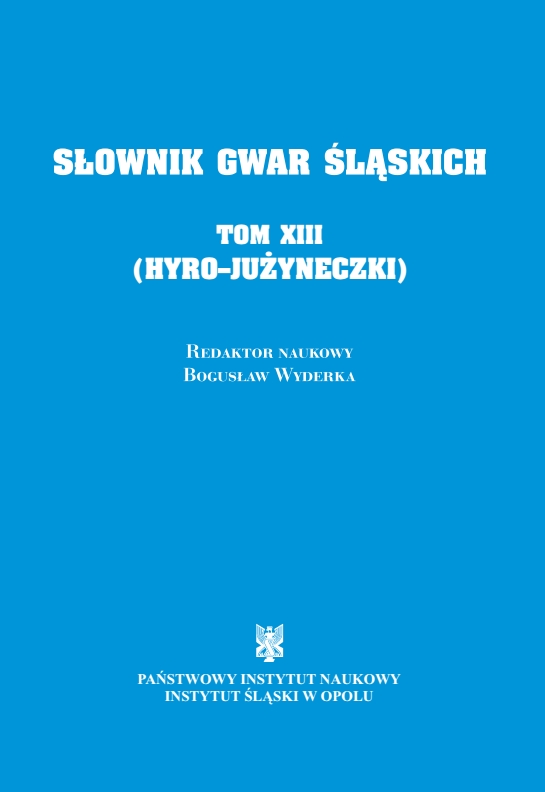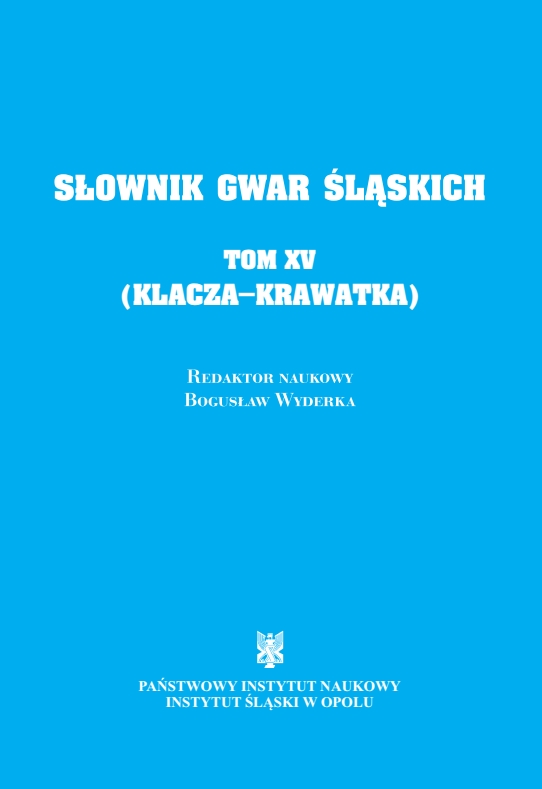
Słownik Gwar Śląskich, tom VII (DĄB - DOZIERAĆ)
"Glossary of Silesian Dialects" is the result of many years of scientific work of several generations of linguists from the Silesian Institute in Opole, Poland.
More...We kindly inform you that, as long as the subject affiliation of our 300.000+ articles is in progress, you might get unsufficient or no results on your third level or second level search. In this case, please broaden your search criteria.

"Glossary of Silesian Dialects" is the result of many years of scientific work of several generations of linguists from the Silesian Institute in Opole, Poland.
More...
"Glossary of Silesian Dialects" is the result of many years of scientific work of several generations of linguists from the Silesian Institute in Opole, Poland.
More...
"Glossary of Silesian Dialects" is the result of many years of scientific work of several generations of linguists from the Silesian Institute in Opole, Poland.
More...
"Glossary of Silesian Dialects" is the result of many years of scientific work of several generations of linguists from the Silesian Institute in Opole, Poland.
More...
"Glossary of Silesian Dialects" is the result of many years of scientific work of several generations of linguists from the Silesian Institute in Opole, Poland.
More...
"Glossary of Silesian Dialects" is the result of many years of scientific work of several generations of linguists from the Silesian Institute in Opole, Poland.
More...
"Glossary of Silesian Dialects" is the result of many years of scientific work of several generations of linguists from the Silesian Institute in Opole, Poland.
More...
"Glossary of Silesian Dialects" is the result of many years of scientific work of several generations of linguists from the Silesian Institute in Opole, Poland.
More...
"Glossary of Silesian Dialects" is the result of many years of scientific work of several generations of linguists from the Silesian Institute in Opole, Poland.
More...
"Glossary of Silesian Dialects" is the result of many years of scientific work of several generations of linguists from the Silesian Institute in Opole, Poland.
More...
"Glossary of Silesian Dialects" is the result of many years of scientific work of several generations of linguists from the Silesian Institute in Opole, Poland.
More...
Helena Krasowska's "The Polish Minority in South-Eastern Ukraine" presents the Polish cultural heritage in Zaporizhzhia and Donetsk Oblasts, including the current state of the local Polish language, its scope and functions, as well as the local determinants of Polish identity. Presentation of linguistic research is preceded by an extensive chapter on the region's history, and ethnic and national situation, with an overview of the legal status of minority organizations, focusing on the post-perestroika situation of the Polish minority. This historical and legal information helps grasp the complex subject-matter of the region's languages.
More...
The eight volume of the series The richness of the Polish language in the light of its history is a publication that presents the achievements of the national scientific conference (Katowice, 7 November 2018). The authors of the articles collected in this volume have made various historical and linguistic issues, primarily: description of old and contemporary lexis oriented in terms of vocabulary, semantics or etymology; the problems of nominations in the history of the Polish language; conceptualisation of different concepts in both language and culture. Due to the diversity of thematic circles this book was divided into three parts (From history to modernity – continuity, change, inspirations; From word to meaning - etymology, transformations, variants; From sign to text - syntax, genres, functions), showing a wide spectrum of scientific interests of the researchers.
More...
This handbook aims at introducing the students of French philology and French applied to economics to French and general linguistics. That's why it focuses on the main fields of linguistics: phonetics, morphology, syntax, semantics, etc., but also on topics permit to have an overview of the problems of the science of language, like the notion of sign, the classification of languages or the communication. This book proposes numerous excercices after almost each chapter, so the students have the opportunity to train with the different points which are mentioned. The handbook is written in French and gets the students familiarized with the grammatical terminology.
More...
The set of problems engaged in the texts which are presented in the monograph reflects the multifariousness of research perspectives in modern Slavic linguistics with reference to both traditional and novel methodological approaches. The authors’ focus has to do with the problems of the description of the units of the Polish, Russian, Ukrainian, Czech and Croatian languages at the particular levels of these languages. The linguistic units are examined not only as elements of a system but also as components (which are varied genre-wise) of early and modern texts. Apart from the analyses which draw from structuralist traditions there are also ones in which linguistic phenomena are considered in a broad social-political-cultural context. The publication is a collection of pieces which are devoted both to one language as well as comparative studies: Polish-Russian, Polish-Czech, Polish-Croatian, Russian-Czech ones. There are also texts which are devoted to the problems of translatology. The broad range of problems which are engaged by the authors from Poland and beyond enables the reader to familiarise himself or herself with the areas and trends of work conducted by the particular academic centres. We hope that it will also become a source of inspiration for further research endeavours.
More...
The aim of the publication is to list the chosen Czech, Moravian and Silesian place names which reflect the names of trees, bushes and shrubs. Trees and bushes, especially solitary ones, have drawn people's attention for centuries, for which reason they have served mainly for specifying location, direction or orientation in an area. The book contains the list of some places named after woody plants. In addition, the related municipal locations are recorded in the form of public online maps for the further use of readers. All gathered data must be treated with caution, because the proper names show a specific linguistic characteristic. The author explains that the purpose of the selected proper names is not to transmit an image of the past or contemporary landscape, but she stresses that the proper names themselves can help a great deal to reveal either a past or contemporary mutual relationship between the landscape and its inhabitants.
More...
The collective monograph describes the investigation of specific determinants and mechanisms of disorders of verbal and non-verbal communication, voice, linguistic-cognitive and orofacial processes from the logopedic and special pedagogical point of view with transdisciplinary overlap into the linguistic, vocological, physiotherapeutic and psycholinguistic areas for use by the academic, scientific, clinical, educational, and counselling public. The book deals with 9 selected disorders and specifics of communication, including phonation and resonance, phatic functions, lexia and orofacial, neurodevelopmental and symptomatic speech disorders. It brings many original and innovative insights expanding the current state of knowledge in the sciences of human communication and speech-language therapy.
More...
From a mysterious text from the 15th century through authorship attribution in internet communication to the analysis of prefixes in forensic linguistics. That is Thrice About Authorship – a book of three student works that combines forensic linguistics and the search for the origin and authors of texts. The first part discusses the methods used to determine the origin of the Voynich Manuscript – a mysterious text written in an unknown script. The second part seeks to say whether it is possible to distinguish the authors of comments from news servers, using methods that enumerate selected linguistic features. The third part also falls into the field of forensic linguistics – it examines the possibility of using the frequency of prefixes to differentiate text writers.
More...
The monograph illustrates the language specific realization of plausibly universal principles of language structure. The study attempts to cover the most basic (regular) parts of English grammar as a whole consistently, within a single compatible framework, but at the same time to present empirically based arguments in favour of specific analyses. She utilizes as often as possible standard scientific argumentation leading to the most generally accepted and best supported analysis of the chosen phenomena. The study is intended for Czech academic audience and therefore it also contains several typologically relevant comparison of English and Czech structures.
More...
The description of the system of the parts of a sentence in Russian and Czech is one of the topical question in contemporary linguistics. In contemporary grammar books, the interpretation of the parts of a sentence is focused mainly on typical phenomena. Peripheral phenomena are often mentioned marginally; similar phenomena are understood differently in various publications. Sometimes, the fluency of transitions between individual parts of a sentence is being emphasized. In our research, we are focused on description of these peripheral phenomena in the system of the parts of a sentence, which represent one of the examples of linguistic syncretism. The term syncretism is defined in the book and various approaches of linguists to phenomena that we perceive as syncretic are presented.
More...